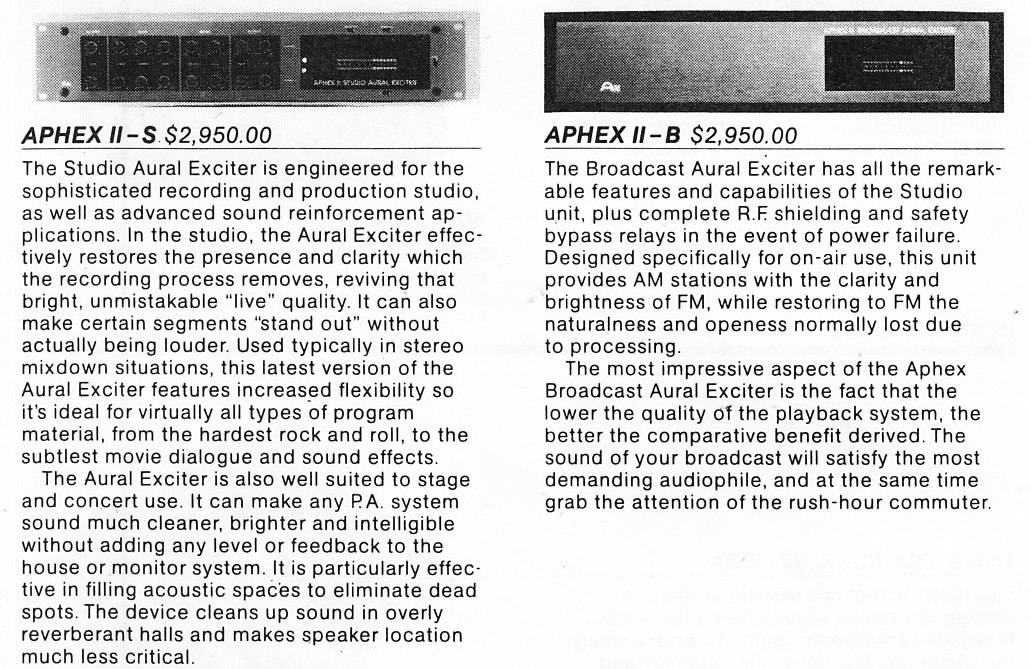*********
*****
Download 6 pages of Aphex Systems INC sales material circa 1984. Details on the entire lineup, plus full specs on the Type B and Type C ‘Aural Exciters.’
DOWNLOAD: Aphex_exciter
Products covered, with specs and photos, include: Aphex II-S Exciter; Aphex II-B exciter; Type B and Type C exciter; Compellor Compressor; EQF-2 and CX-1 lunchbox cards; Aphex R-1 10-space rack and PS-1 power supply; 4B-1 self-powered 4-slot lunchbox; Aphex 2521 op amp, 1537A VCA IC and VCA cards 500A and 505.
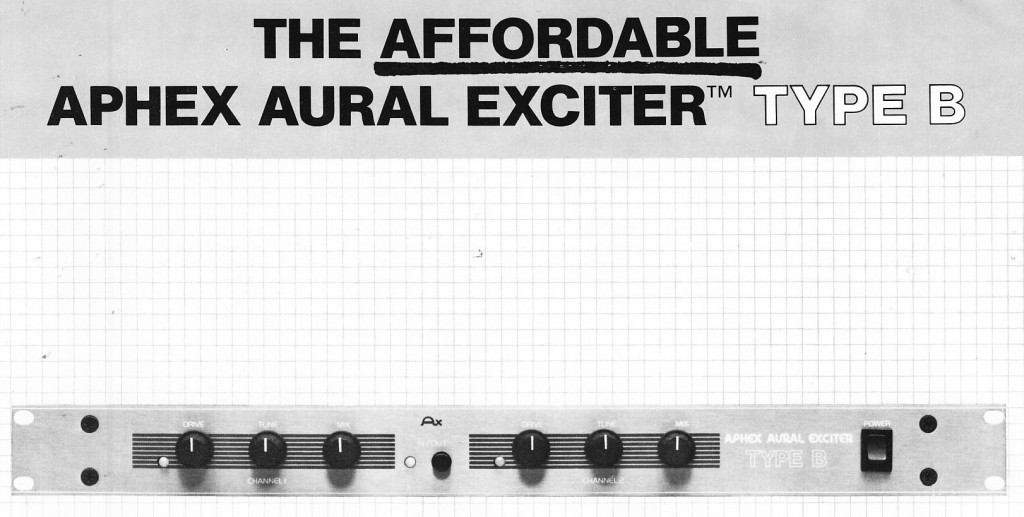
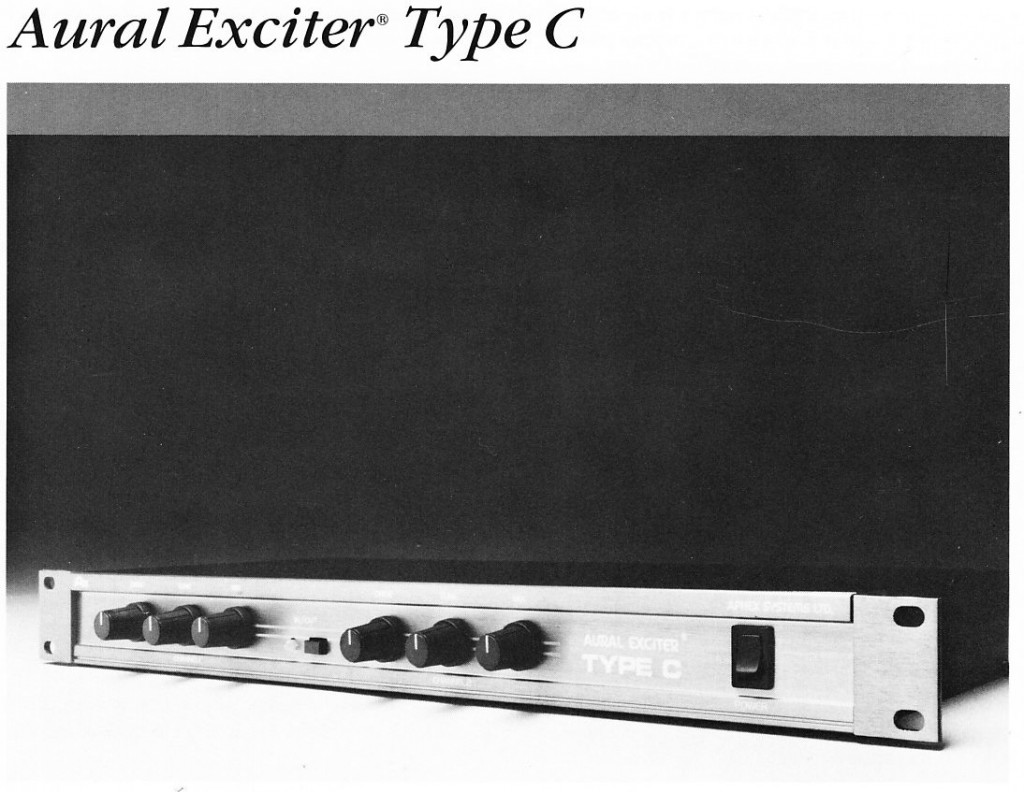 Aural Exciters are essentially dynamic equalizers; as-in; rather than deriving their frequency-manipulation parameters from a set of fixed (or user-variable) static controls, the frequency-manipulation is, in one way or another, dependent on the program material. Furthermore, in the case of the Aphex exciters, the ‘equalization’ is accomplished not by the selective cutting and boosting of certain frequencies, but by essentially creating a distorted duplicate of some of the lower frequencies of the program material and then mixing this distorted signal back into the program with some amount of slight time adjustment; and all of this action is further dependent on the program level.
Aural Exciters are essentially dynamic equalizers; as-in; rather than deriving their frequency-manipulation parameters from a set of fixed (or user-variable) static controls, the frequency-manipulation is, in one way or another, dependent on the program material. Furthermore, in the case of the Aphex exciters, the ‘equalization’ is accomplished not by the selective cutting and boosting of certain frequencies, but by essentially creating a distorted duplicate of some of the lower frequencies of the program material and then mixing this distorted signal back into the program with some amount of slight time adjustment; and all of this action is further dependent on the program level.
Aphex was the company that popularized these devices; in fact, many major-label records from the late 70s actually go so far as to credit these devices by name in the liner notes of the album. This was practiced in the early days of Aphex, when the devices were not even available for sale; instead, studios had to pay to rent the devices at a cost of $30 per minute of program material. Consider what this meant. If you were mixing, say, a 40-minute rock album in 1977, and you wanted the ‘aphex process’ used on the whole record, it would cost you $1200. Which is $4300 in today’s money. Wow. Imagine if plug-ins were rented this way today.
I used one of the cheap-o ‘Exciter C’ units back in the mid-90s; it was a good way to compensate for the poor sound quality we experienced when bouncing down tracks on a 4-track cassette machine or the TSR-8 tascam 8-track. I later replaced the Aphex with a slightly more advanced BBE 862, which operates on somewhat different principles but offers a very similar overall effect. I still find the BBE useful in the studio; not for the ‘exciter’ high-end boost, which sounds very brittle and artificial, but for the powerful low-end enhancement it offers. I imagine the plug-in sounds much the same.
Although Aphex may have brought significant advancement to the field of ‘psychoacoustic processors,’ of which the Aural Exciter is certainly one example, they did not create this product category. Several devices were available as early as the early 1960s which promised dynamic, program-dependent equalization of audio material.
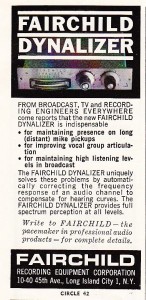 Once such example is the Fairchild 673 “Dynalizer” Dynamic Equalizer. In an excerpt from an excellent post on Pro Sound Web, noted audio-expert John Klett describes the 673:
Once such example is the Fairchild 673 “Dynalizer” Dynamic Equalizer. In an excerpt from an excellent post on Pro Sound Web, noted audio-expert John Klett describes the 673:
“673 “Dynalizer” Dynamic Equalizer – does a Fletcher Munson Loudness curve equalization and boosts highs and lows as level drops – like an automatic loudness control. This uses the same optical system as 661 and 663… kind of slow and stupid but – who knows – possibly useful as a “thing”. You would have to get the gain structure around this right to make it work “well”.”
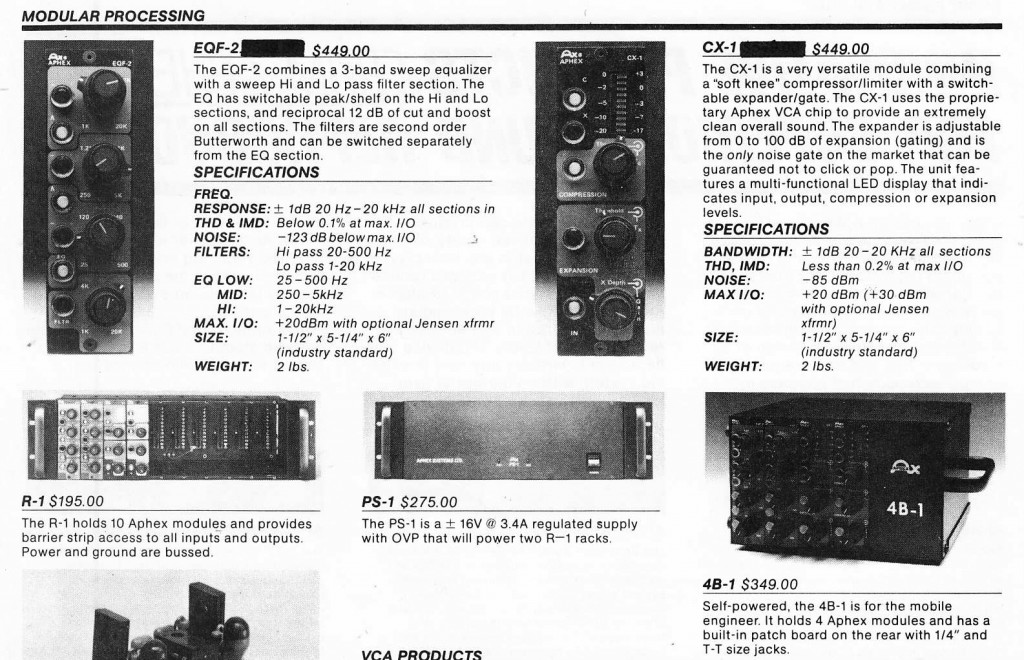 In the download, you can also find information on Aphex’ small line-up of API-500-spec processing cards: the EQF-2 equalizer and the the CX-1 compressor. I have never used these units personally, but according to this website they are in fact compatible with the API-500 standard.
In the download, you can also find information on Aphex’ small line-up of API-500-spec processing cards: the EQF-2 equalizer and the the CX-1 compressor. I have never used these units personally, but according to this website they are in fact compatible with the API-500 standard.
